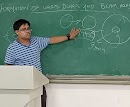Derivations
The Quantum Superposition Theorem: A Mathematical Approach
In my earlier
articles, I have written mostly about the theoretical side of the story of
Quantum Superposition. Quantum superposition is one of the main corner-stone theory which gives the weirdness to Quantum physics and helps us to solve
critical problems like Quantum tunneling.
In my last article, I wrote about the Orthogonality theorem which is a necessary
prerequisite to understand the mathematics behind Quantum Superposition. Along
with this, preliminary calculus with knowledge of probability is required to
understand the following text as it may not seem to be that fancy as you see in
documentaries rather if you understand the text then it is more fascinating and
support the statement: “Facts are stranger than Fiction”.
So, without much
further delay, let’s dive into it…..
To formulate
superposition principle, firstly we have to consider some potential V(x) and
for this potential Schrodinger’s equation has been solved. This yield a number
of wave-functions 𝜓ᵢ(x) and their corresponding Eigenvalues for energy Eᵢ.
Now, we have to combine each individual solution by linear
summation to construct another function 𝚿(x) and called it as ‘Super-Wave Function’.
𝚿(x) = 𝚺ᵢ aᵢ𝜓ᵢ(x) (1)
Here, aᵢ are the expansion coefficients. The expansion
coefficients, aᵢ represent the degree to which the full wavefunction possesses the character of the eigenfunction 𝜓ᵢ.
Also, by analogy, you can say that the coefficients are the
projections of the wavefunction on to the eigenfunctions of the operator.
Normalization of 𝚿(x)
over the range of 𝜓ᵢ(x) leads
us to,
∫ 𝚿 𝚿*dx = 1
∫ (𝚺ᵢ aᵢ𝜓ᵢ)( 𝚺ⱼ aⱼ*𝜓ⱼ*) = 1 (2)
Now we can swap
order if the integration and summation in as it possible without loss of generality
in equation 2. So, after swapping we get,
𝚺ᵢ 𝚺ⱼ aᵢ aⱼ* ⟨𝜓ᵢ | 𝜓ⱼ*⟩ = 1 (3)
Here, after
rearranging, wave functions for i and j has been represented by Dirac notation.
If you know about the Orthogonality theorem, then you must be familiar with
this notation. If you don’t know about it, then I strongly recommend you to
read it first and then proceed forward.
So, after the
above steps, we can use Orthogonality theorem to simplify the equation 3. As we
know that, ⟨𝜓ᵢ | 𝜓ⱼ*⟩ can be simplified
to ẟᵢ^j. Again from Orthogonality
theorem, we know that ẟᵢ^
j is 1 only when
i=j. For all other conditions, it is 0. Also, aᵢ aᵢ* = aᵢ².
So, now our equation 3 is modified to,
𝚺ᵢ aᵢ² = 1 (4)
Now, we need to
calculate expectation value of 𝚿(x)
for our further
investigation….
⟨E⟩ = ∫ 𝚿(H 𝚿*)dx = ∫(𝚺ᵢ aᵢ𝜓ᵢ){ H 𝚺ⱼ aⱼ*𝜓ⱼ*} dx (5)
Here, we used
Hamiltonian operator because the general equation of expectation value demands
an operator, and in the case of expectation value of energy the operator is
Hamiltonian (H).
Also, from basic
quantum physics, we know,
H(𝜓ᵢ) = Eᵢ 𝜓ᵢ (6)
Now, from eq. 5
and 6,
⟨E⟩ = ∫{ (𝚺ᵢ aᵢ𝜓ᵢ)( 𝚺ⱼ Eⱼ
aⱼ*𝜓ⱼ*) } dx
Again we have to
follow the same procedure as we did to reduce eq. (2) to eq. (3)
⟨E⟩ = 𝚺ᵢ 𝚺ⱼ Eⱼ aᵢ aᵢ* ⟨𝜓ᵢ | 𝜓ⱼ*⟩
And by Orthogonality
theorem,
⟨E⟩ = 𝚺ᵢ Eᵢ aᵢ² (7)
So, from equation 7, we understand that
the expectation value of energy for the superposition state is just the weighted
sum of the energies of the individual energies and multiplied with the square
of the expansion coefficients (weighted factors).
There are two
major postulates of the quantum mechanics and on the basis of these postulates
we can constitute the superposition theorem. They are as follows:
1) If a system can
be in any of the individual eigenstates 𝜓ᵢ, then
it can also be in the superposition state as described by equation 1. Thus,
the system need not to be in an eigenstate and may vary.
2) When someone proceeds to make a measurement to determine the
state of the system, then the super-wave function or superposition state (𝚿) collapses into one of the eigenstates 𝜓ᵢ. To find the probability
of the system in state 𝜓ᵢ
can be calculated by using aᵢ². That’s
why you can see equation 4 has value 1 as the summation of all probabilities is
always 1.
In my further articles, you will be introduced to the formulation
of the mathematical structure of the advance theories like perturbation and variation
methods. These theories are the basis of the approximation methods which are
used in quantum mechanics.
So, don’t forget to subscribe and follow our
website (buttons are available in the right sidebar) and follow me on social media for updates….
To know basics of quantum world, astronomy and space exploration you can check out my book "Through the wormhole" on amazon kindle.
Thanks for Reading!!!
Check out my other blog posts!!!
Don't forget to share this post in your social media handles to enrich everyone's knowledge!!!
You can directly talk with me on Instagram
To meet more physics Enthusiasts please join our Facebook Page
Also for latest updates of my posts join me on Twitter
See you Again!!!!!
-Ratnadeep Das Choudhury
Founder and writer of The Dynamic Frequency













0 Comments